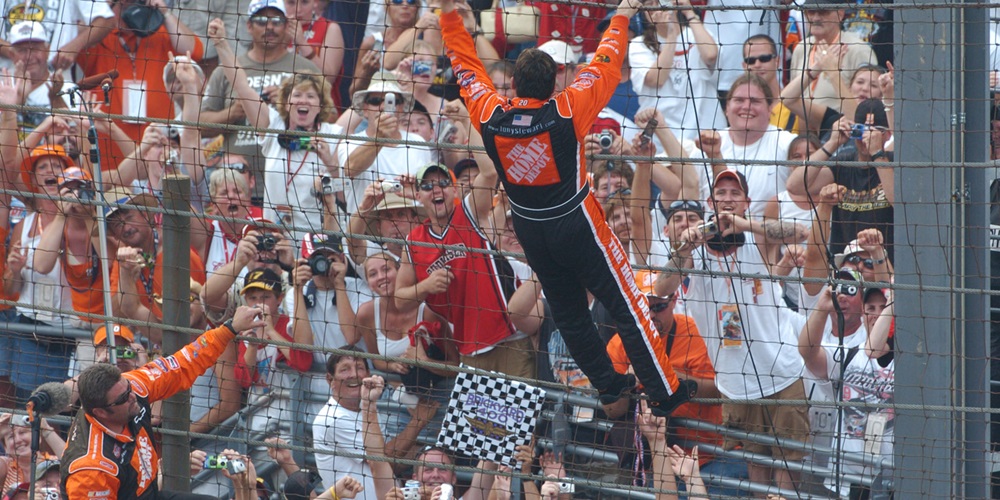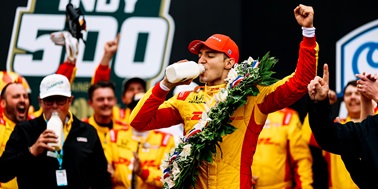Rare is the sportsman who comes to know his field of dreams before he arrives there as a star. Joe DiMaggio never saw the green grass of Yankee Stadium until he sunk his cleats into it as a Major Leaguer. Pete Sampras grew up an ocean and a full continent away from Centre Court at Wimbledon. Augusta National was just a lovely television golf course to Jordan Spieth until he played his first Masters Tournament.
Tony Stewart’s field of dreams, the Indianapolis Motor Speedway, had teased him, flirted with him, and visited him in his slumber long before he ran his first competitive laps there in 1996, in the 80th Indianapolis 500. Five years earlier, as 20-year-old dirt-track racer hustling midget rides and sleeping “in half the spare bedrooms in the state of Indiana,” he made ends meet by driving a wrecker for one of his United States Auto Club rivals.
Anytime a service call took him near the Speedway, Stewart would go out of his way to drive south down Georgetown Road, which parallels the grand old track’s front straightaway and the property’s chain-link perimeter, glancing to his left every time he passed a gap in the massive grandstands. He had one thought on his mind: “Man, what would it be like to be 150 yards inside that fence, running 200 miles per hour?”
He had been inside that fence before, but not far enough inside. At age 5, he’d joined his father and some friends in watching the “500” from grandstand seats so low that he remembers seeing only the tops of the cars skimming by. That set the hook: Each subsequent May, weekday afternoons would find him physically present in classrooms in his native Columbus, Indiana, but mentally 50 miles to the north, where he knew the heroes of the day – Mario Andretti, Bobby and Al Unser, Johnny Rutherford, young Rick Mears, and especially A.J. Foyt, who became his idol – were rolling in and out of Gasoline Alley, preparing their cars for the Memorial Day weekend classic.
The daily practice sessions at IMS were televised in those days, so Stewart fell into a daily routine: “You’d get done with school at 3:30 [p.m.]. Then you got on your bike and rode as fast as you could to get home and turn on your TV to watch.”
By that point in his life, Indianapolis “was a dream.” A whole field of them.
Is it any wonder, then, that whenever he’s endured a bad day there as a driver – whether in the Indianapolis 500 or NASCAR’s Brickyard 400 – it seemed to hang around his neck like the weight of a lifetime’s struggle, rather than the disappointment of a single hard-luck day? When he blew an engine in the 1997 edition of the “500,” less than a lap after he’d taken the lead, he famously muttered in a television interview, “This is the only thing I’ve ever wanted to do in my life. This has been my number one goal. And every year, I get [crapped] on doing it.”
It was only his third “500,” so that comment wasn’t likely to gain him any sympathy from, say, Lloyd Ruby, Indy’s perennial hard-luck driver, who made 18 starts in the “500,” led often, and never finished better than third. Or Michael Andretti, who has the sorry distinction of being the driver to lead the most laps in the “500” without ever having won the great race. They might have seen Stewart’s remark as the petulant complaint of a kid who didn’t yet know how disappointing Indianapolis could truly be.
What they wouldn’t have understood was that in his gut and in his heart, Tony Stewart had been trying to win at Indianapolis for as long as he could remember. Since he was that wrecker driver, barely out of his teens. Since he was that boy on the bicycle, pedaling furiously toward home to watch practice.
That was why, after he won the Brickyard 400 in 2005 – having outdueled his good friend Kasey Kahne – Stewart exulted with a joy that surprised even his close friends. On the cool-down lap he pumped a tightly clenched fist, oblivious to the millions at home watching via his in-car camera. He skidded to a halt beneath the Turn 2 suite he had rented for years and climbed out to salute the family and friends he knew were gathered there.
When he finally drove around to the frontstretch, he climbed the catch fence, letting the cheers of the partisan Indiana crowd wash over him. And when the wave of adrenaline he’d been surfing broke as he began his network television interview – nine full minutes after taking the checkered flag – he simply laid down atop the retaining wall at the start/finish line, too drained to stand.
The win vaulted him into the lead in the points standings, and toward what would be his second Cup series title. But on Aug. 7, 2005, none of that meant a damn thing. This had been, counting his starts in the “500,” the 400, and the International Race of Champions series, Stewart’s 16th race at Indianapolis. Who knows how many more he had run while lost in thought in those Columbus classrooms? Finally, he had beaten the joint.
“Today,” he told NBC’s Allen Bestwick, “has been my entire life.”
It was, he has said many times since that day, “just like taking the weight of the world off your shoulders.”
Which went a long way toward explaining the fact that, when he won there for a second time in the 2007 edition of the Brickyard 400 – on a day when Jeff Gordon said, “Nobody had anything for Tony” – Stewart seemed more relieved than downright joyous, as if the result was more reminder than revelation. Once the weight of the world is gone, it stays gone.
Green Bay Packers coaching legend Vince Lombardi used to tell his players, “When you get into the end zone, act like you’ve been there before.” Celebrating that 2007 victory, that’s just how Stewart looked. Later he confirmed that having already won at Indianapolis, having climbed that mountain, had forever changed the way he viewed the Speedway: “It wasn’t untouchable any more.”
Running the 2007 race, he knew that “it wasn’t like my whole life depends on whether I pass this one car in front of me or not.” Two years earlier, he admitted, passing Kahne had been “like a life-or-death situation for me.”
A lot has changed for Stewart in the years since that last Brickyard 400 score. He is a three-time NASCAR Cup Series champion, an NTT INDYCAR SERIES champion and a four-time USAC champion. He has been an enormously successful NASCAR team owner, partnering with California industrialist Gene Haas to win dozens of races with Stewart-Haas Racing, as well as a pair of Cup Series titles, in 2011 with himself and in 2014 with Kevin Harvick.
In 2013, the team gave Stewart another taste of Indianapolis glory when Ryan Newman – a fellow Hoosier native and USAC graduate – drove an SHR car beneath the Brickyard 400 checkers.
So, Stewart’s place in American racing history is secure. And soon his driving career – at least what the mainstream media and casual fans would consider the big-league portion of it – will be history, too.
Stewart raced in his final event at the Brickyard in 2016, the final season of his illustrious NASCAR Cup Series career.
You do have to wonder if he’ll miss driving at Indianapolis, at the Speedway, at the place that teased him and flirted with him and, later, crushed his spirit a time or two before twice taking him to heaven.
In quiet moments, Stewart can captivate a listener when he talks about the intricacies and intangibles of this track he has loved for so long: its tricky wind gusts, the way the asphalt’s grip level changes with each rise and fall in temperature, the fact that all four of its 90-degree turns might look the same to a layman, but require very different approaches. He has a lot of those intangibles figured out.
He knows things about the Indianapolis Motor Speedway that most of us never will. For example, how those 90-degree corners and the track’s towering grandstands mean that four times per lap, the crowd in its multi-colored splendor is right there, straight ahead, looming. And how on the last lap of any Indianapolis race those grandstands look suddenly different, filled with standing fans willing the leader on.
“That’s what makes that last lap so special, versus anywhere else you go,” he said. “Those people, they know you’ve still got to make four good corners, but they’re cheering that last lap, like, ‘This is yours, this is yours. All you’ve got to do is get around one more time.’”
He knows things like this, because he’s been there. Joe DiMaggio made the Yankee Stadium outfield his own. With Stewart and Indianapolis, it was the other way around: The Speedway made Tony one of its own long before he’d even realized it.
A few years back, on another Brickyard 400 weekend, someone asked him if showing up at Indianapolis for a race weekend still felt special. For a moment he was quiet, with the faraway look of a five-year-old kid in the cheap seats, or a young man daydreaming in a tow truck. Then Tony Stewart smiled a bit.
“It was special from Day One, and I don’t think it’s ever changed,” he said. “You get that tickle in your stomach that tells you, you’re home.”




